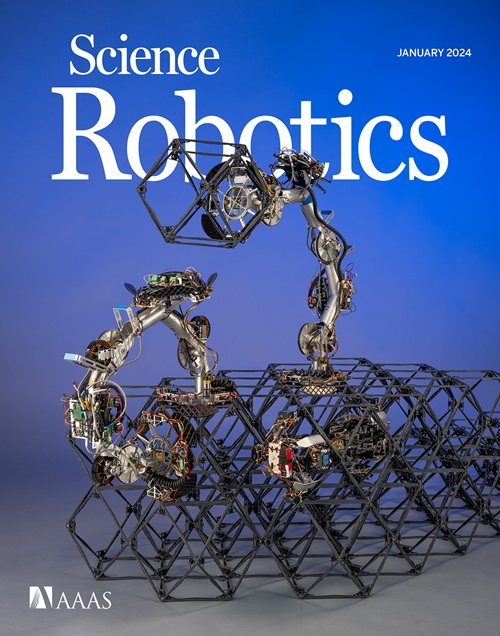Harnessing the oloid shape in magnetically driven robots to enable high-resolution ultrasound imaging
IF 27.5
1区 计算机科学
Q1 ROBOTICS
引用次数: 0
Abstract
Magnetic fields enable remote manipulation of objects and are ideal for medical applications because they pass through human tissue harmlessly. This capability is promising for surgical robots, allowing navigation deeper into the human anatomy and accessing organs beyond the reach of current technologies. However, magnetic manipulation is typically limited to a maximum two–degrees-of-freedom orientation, restricting complex motions, especially those including rolling around the main axis of the magnetic robot. To address this challenge, we introduce a robot design inspired by embodied intelligence and the unique geometry of developable rollers, leveraging the oloid shape. The oloid, with its axial asymmetry and sinusoidal motion, facilitates rolling when precisely controlled by an external magnetic field. We present a versatile closed-loop control model to ensure precise magnetic manipulation of an oloid-shaped robot. This capability was validated in endoluminal applications through the integration of a 28-megahertz micro-ultrasound array to perform virtual biopsies, noninvasive real-time histological imaging. Extensive in vitro and in vivo tests using a porcine model showed the robot’s ability to execute sweeping motions, identify lesions, and generate detailed three-dimensional scans of gastrointestinal subsurface tissue. This research not only restores a critical movement capability to magnetic medical robots but also enables additional clinical applications deep within the human body.
利用磁性驱动机器人的形状来实现高分辨率超声成像
磁场可以实现对物体的远程操作,并且由于它们无害地穿过人体组织,因此是医疗应用的理想选择。这种能力对于外科手术机器人来说是很有希望的,它允许更深入地进入人体解剖结构,并访问当前技术无法达到的器官。然而,磁性操作通常限于最大两个自由度的方向,限制了复杂的运动,特别是那些包括绕磁性机器人主轴滚动的运动。为了解决这一挑战,我们引入了一种机器人设计,灵感来自具身智能和独特的可展开滚子几何形状,利用了椭球形状。由于其轴向不对称和正弦运动,在外部磁场的精确控制下,有利于滚动。我们提出了一种多功能闭环控制模型,以确保对一个椭球形机器人进行精确的磁操纵。通过集成28兆赫微超声阵列进行虚拟活组织检查和无创实时组织学成像,该功能在腔内应用中得到了验证。利用猪模型进行的大量体外和体内测试表明,该机器人能够进行扫地运动,识别病变,并对胃肠道表面下组织进行详细的三维扫描。这项研究不仅恢复了磁性医疗机器人的关键运动能力,而且还使其在人体深处的其他临床应用成为可能。
本文章由计算机程序翻译,如有差异,请以英文原文为准。
求助全文
约1分钟内获得全文
求助全文
来源期刊

Science Robotics
Mathematics-Control and Optimization
CiteScore
30.60
自引率
2.80%
发文量
83
期刊介绍:
Science Robotics publishes original, peer-reviewed, science- or engineering-based research articles that advance the field of robotics. The journal also features editor-commissioned Reviews. An international team of academic editors holds Science Robotics articles to the same high-quality standard that is the hallmark of the Science family of journals.
Sub-topics include: actuators, advanced materials, artificial Intelligence, autonomous vehicles, bio-inspired design, exoskeletons, fabrication, field robotics, human-robot interaction, humanoids, industrial robotics, kinematics, machine learning, material science, medical technology, motion planning and control, micro- and nano-robotics, multi-robot control, sensors, service robotics, social and ethical issues, soft robotics, and space, planetary and undersea exploration.
 求助内容:
求助内容: 应助结果提醒方式:
应助结果提醒方式:


